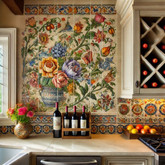From Clay to Color: The Ultimate Guide to Mexican Terracotta, Tile Murals and Patterned Talavera
Few materials capture Mexico’s artistic heritage as vividly as its hand-crafted tiles. Whether you want the earthy warmth of terracotta pavers, a story-telling Talavera mural above your stove, or graphic pattern tiles on a stair riser, each piece is shaped, painted and fired by artisans whose skills have passed through generations. This 1 400-word guide synthesizes the signature collections of MexicanTileStore.com to help you choose, install and style tiles that will last a lifetime.
1. Terracotta Floor Tiles: Durable Warmth Underfoot
Terracotta floor tiles begin as red clay mined in the central state of Guanajuato. After being hand-pressed into molds, they are sun-dried and baked in traditional kilns, creating subtle color variation that ranges from pale peach to deep burnt orange. Once sealed, the surface darkens slightly, becomes water-resistant, and stands up to decades of foot traffic indoors or out.
Installation essentials:
- Pre-seal every tile—especially porous Saltillo pieces—to prevent grout haze.
- Use a high-flex thin-set mortar; terracotta expands and contracts with temperature swings.
- Refresh the penetrating sealer every two to three years in high-traffic zones.
Design tip: Mix 6″ × 6″ squares with 4″ × 8″ rectangular inserts to create a classic hacienda checkerboard, or frame a dining area with a Talavera border for a “rug” effect.
2. Hand-Painted Tile Murals: Turning Walls into Canvases
If terracotta provides the earthy base, hand-painted murals bring narrative and color. Each design—whether a tranquil countryside, a bowl of tropical fruit or a religious icon—is painted on individual 4″ × 4″ Talavera tiles, then glazed and kiln-fired for a glossy, easy-clean surface.
Popular formats include the 28″ × 36″ “Saint Anthony of Padua” mural, composed of 4″ × 4″ ceramic tiles and shipped within six weeks, free to the U.S. mainland. Because each tile is numbered on the back, you can lay the scene on a flat table before transferring it to the backsplash, shower wall or patio niche.
Where murals shine:
- Kitchen backsplashes—they shrug off grease and wipe clean with mild soap.
- Outdoor grilling stations—Talavera’s glazed finish resists UV fading.
- Bathroom feature walls—pair with neutral limestone for a gallery feel.
3. Pattern Tiles: Geometry, Florals & Endless Possibilities
For movement and rhythm, choose Mexican pattern tiles. These Talavera squares display everything from Moorish-inspired starbursts to vivid florals in cobalt blue, marigold and emerald. Because each batch is hand-mixed and double-fired, no two tiles are exactly alike—a hallmark of authenticity that mass-produced ceramics can’t match.
Use pattern tiles to:
- Highlight stair risers: alternate two coordinating motifs for a playful, kinetic look.
- Fireplace surrounds: frame the opening in geometric Talavera, then use matte terracotta on the hearth.
- Wet bars & niches: cover small recessed areas to add a pop of color without overwhelming the room.
Most designs are available in 4″ × 4″ and 6″ × 6″ formats with a uniform 5 mm thickness, making transitions to plaster or painted drywall straightforward.
4. Blending Collections Like a Pro
Follow the 60-30-10 rule: let neutral terracotta cover roughly 60 % of the surface, reserve 30 % for patterned Talavera accents, and dedicate the final 10 % to a mural focal point. Limiting your palette to three dominant colors keeps the scheme cohesive.
In open-plan homes, transition seamlessly: start with terracotta pavers in the foyer, switch to patterned tiles on a kitchen island base, and crown the cooking zone with a hand-painted mural. The varying textures—unglazed clay below, glossy glaze above—add visual depth.
5. Care & Maintenance for Decades of Beauty
Terracotta
Because it is naturally porous, terracotta demands a penetrating sealer before and after grouting. Use pH-neutral cleaners; acidic agents will etch the clay.
Glazed Talavera (Murals & Pattern Tiles)
Opt for unsanded grout lines under 1/8″ to avoid scratching the glaze. Wipe spills promptly and avoid abrasive pads.
Seasonal Checks
Exterior installations should be resealed at the start of each rainy season. Inspect for efflorescence (white salt deposits); if present, clean with a mixture of water and mild detergent, then allow the surface to dry completely before resealing.
6. Cultural Significance & Modern Trends
Mexican tile art blends Spanish colonial, Moorish and Indigenous influences. Today’s designers pair polished concrete countertops with rustic terracotta, or wrap minimalist bathrooms in monochrome pattern tiles for a contemporary-meets-heritage aesthetic. The modern rustic movement, in particular, showcases matte clay floors beneath matte-black fixtures, letting Talavera accents supply the color story.
Public artists such as Natasha Moraga have elevated community mosaics, proving that hand-painted tiles can scale from a single backsplash to entire urban staircases. By choosing authentic Mexican tiles, homeowners support time-honoured craft and sustain local economies.
Conclusion: Craft Your Own Legacy
Terracotta floors ground a space in earthy resilience; Talavera murals tell stories across glossy surfaces; patterned tiles weave rhythm and personality. Together, these collections from MexicanTileStore.com give you the tools to shape rooms that feel both timeless and unmistakably yours. Plan thoughtfully, seal diligently, and your handcrafted tiles will age gracefully—ready to greet the next generation with the same warmth and color that first caught your eye.



